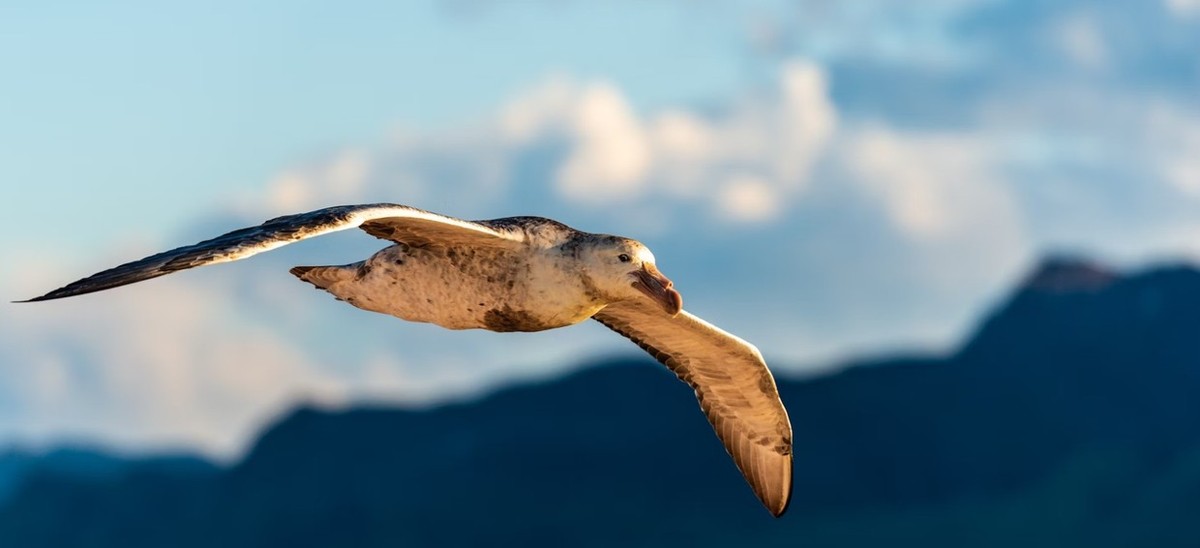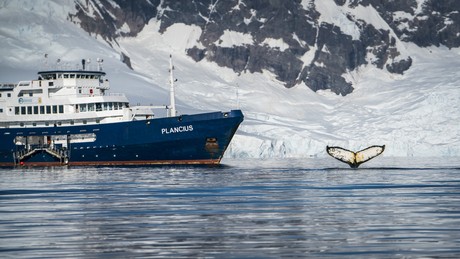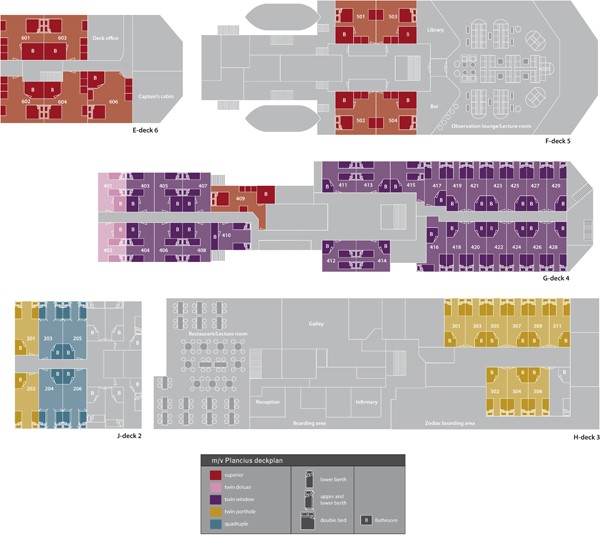
Few places compare to South Georgia in terms of exotic wildlife and jaw-dropping scenery. On this exploratory voyage you can enjoy wandering albatross colonies while also seeing some of the biggest breeding spots for king penguins and elephant seals on Earth – along with day after day of amazing polar scenery.
Ski Trekking South Georgia: -
A group of adventurers aboard this voyage will travel part of Shackleton's historic route through South Georgia. They will begin their adventure in King Haakon Bay and be picked up a few days later in Stromness Bay.
Fancy an exceptionally unique adventure? Then consider joining our exciting ski trek that follows part of Ernest Shackleton's famous 1916 route through South Georgia. Check out the details here and contact us for more information.
- Ski Trekking South Georgia - Make an exhilarating ski crossing of South Georgia, following part of legendary explorer Ernest Shackleton’s famous 1916 route
- Grytviken - An impressive remnant of early 20th-century whaling, Grytviken is a well-preserved former station abandoned by Norwegian hunters after they had exhausted the local whale population
- Gold Harbour - Thousands of king penguins, hundreds of gentoos, and loads of elephant seals share this awesomely scenic South Georgia bay
- Stromness - The famed whaling station where Shackleton found help for his stranded crew
- Chinstrap Penguin - Though armed with the "stonebreaker" nickname and a quarrelsome reputation, these gentoo relatives are fading from the Antarctic – probably due to climate change
- Southern Elephant Seal - The largest of their species, southern elephant seals are often found in haul-outs along Antarctic coastlines
- Macaroni Penguin - Named for their orange plume feathers, these shallow-nesting hoppers are the largest of the crested penguins
Prices quoted here are often dependent on currency fluctuations. Please check with (01432 507450 or info@small-cruise-ships.com) for the very latest price, which may well be cheaper than the one advertised here.






Your voyage begins where the world drops off. Ushuaia, Argentina, reputed to be the southernmost city on the planet, is located on the far southern tip of South America. Starting in the afternoon, you embark from this small resort town on Tierra del Fuego, nicknamed “The End of the World,” and sail the mountain-fringed Beagle Channel for the remainder of the evening.
En route to South Georgia, you cross the Antarctic Convergence. The temperature cools considerably within the space of a few hours, and nutritious water rises to the surface of the sea due to colliding water columns. This phenomenon attracts a multitude of seabirds near the ship, including several species of albatross, shearwaters, petrels, prions, and skuas.
Depending on weather conditions, we may sail past Shag Rocks. This small group of 6 islands on the South Georgia Ridge in shallower waters. The nutrient-rich waters in this area offers a lot of food for birds and whales. The islands are named after the South Georgian Shags, known for their bright blue eyes and yellow patch on their beak.
Today you arrive at the first South Georgia activity site. Please keep in mind that weather conditions in this area can be challenging, largely dictating the program.
Sites you might visit include:
Salisbury Plain, St. Andrews Bay, Gold Harbour – These sites not only house the three largest king penguin colonies in South Georgia, they’re also three of the world’s largest breeding beaches for southern elephant seals. Only during this time of year do they peak in their breeding cycle. Watch the four-ton bulls keep a constant vigil (and occasionally fight) over territories where dozens of females have just given birth or are about to deliver. You can also see a substantial number of Antarctic fur seals here.
Fortuna Bay – A beautiful outwash plain from Fortuna Glacier is home to a large number of king penguins and seals. You may have the chance to follow the final leg of Shackleton’s route to the abandoned whaling village of Stromness. This path cuts across the mountain pass beyond Shackleton’s Waterfall, and as the terrain is partly swampy, be prepared to cross a few small streams.
Leith Harbour, Stromness, Husvik – These sites remind us of the scale of the whaling industry in the early 20th century. Elephant and fur seals breed and moult here. Gentoo penguins also occupy the landing sites. Antarctic prions and South Georgia dive petrels may be observed, especially in the area of Husvik.
Grytviken – In this abandoned whaling station, king penguins walk the streets and elephant seals lie around like they own the place – because they basically do. Here you might be able to see the South Georgia Museum as well as Shackleton’s grave.
Cobblers Cove, Godthul – At Cobblers Cove we aim for Rookery Point to see macaroni penguins. Light-mantled sooty albatrosses nest along the coastline and giant petrels can be observed as well. Godthul (Norwegian for “good cove”) was named by Norwegian whalers and seal-hunters and remains such as bones can still be found along the shore line. Beaches are the home of gentoo penguins and seals.
Royal Bay (Moltke Harbour, Will Point & Brisbane Point) – Moltke harbour in Royal Bay was named by the German International Polar Year Expedition in 1882 and some of the remains of their dwellings are still visible. The scenery of Royal Bay is beautiful, dark sandy beaches, followed by the green tussock colors and finally dominated by the snow and ice covered Ross Glacier. Royal Bay one of the windiest bays on the island, zodiac cruising is spectacular. Approx. 30,000 pairs of king penguins live here.
Cooper Bay – Offers the largest chinstrap penguin population and gentoo and also macaroni penguins are present. Antarctic terns, white-chinned petrels, blue-eyed shags and light-mantled sooty albatrosses can be spotted too.
Drygalski Fjord – offers spectacular landscapes as the ships sails the narrow fjord, with ca. 2 kilometer high mountain peaks at a very close distance.
King Haakon Bay – British explorer Ernest Shackleton reached King Haakon Bay during his journey of 800 sea-miles by open boat “James Caird” from Elephant Island. From here he crossed to Stromness to ask for help to rescue his party at Elephant Island after they had left the Weddell Sea where their ship got crushed by ice. Elephant seals dominate the beaches. Birdwatchers will look out for South Georgia pipits, Antarctic prions as well as common diving and blue petrels.
There may be sea ice on this route, south polar skuas and snow petrels could join the other seabirds such as albatrosses and petrels trailing the vessel. Eventually we reach the Drake Passage and you’re again greeted by the vast array of seabirds remembered from the passage south.
You arrive and disembark in Ushuaia, commonly held to be the world’s most southern city. It is located on the Tierra del Fuego archipelago, nicknamed the “End of the World.” But despite this stopping point, the wealth of memories you’ve made on your Antarctic expedition will travel with you wherever your next adventure lies.
Itineraries are subject to change.
Plancius

| Length | 89 metres |
|---|---|
| Speed | 10-12 knots |
| Crew | 37 |
| Expedition staff | 8 |
| Doctor | 1 on board |
M/V "Plancius" was built in 1976 as an oceanographic research vessel for the Royal Dutch Navy and was named "Hr. Ms. Tydeman". The ship sailed for the Dutch Navy until June 2004 when she was converted into an expedition cruise ship..The vessel was completely rebuilt as a 114-passenger vessel in 2009 and complies with the latest SOLAS-regulations (Safety Of Life At Sea). M/v "Plancius" is classed by Lloyd's Register in London and flies the Dutch flag.
"Plancius" accommodates 114 passengers in 53 passenger cabins with private toilet and shower in 4 quadruple private cabins, 39 twin private cabins (ca. 15 square meters) and 10 twin superior cabins (ca. 21 square meters).All cabins offer lower berths (either two single beds or one queen-size bed), except for the 4 quadruple cabins (for 4 persons in 2x upper and lower beds).The vessel offers a restaurant/lecture room on deck 3 and a spacious observation lounge (with bar) on deck 5 with large windows, offering full panorama view.
Plancius has large open deck spaces (with full walk-around possibilities on deck 3), giving excellent opportunities to enjoy the scenery and wildlife. She is furthermore equipped with 10 Mark V zodiacs, including 40 HP 4-stroke outboard engines and 2 gangways on the starboard side, guaranteeing a swift zodiac operation.M/v "Plancius" is comfortable and nicely decorated, but is not a luxury vessel. Our voyages in the Arctic and Antarctic regions are and will still be primarily defined by an exploratory educational travel programme, spending as much time ashore as possible.
The vessel is equipped with a diesel-electric propulsion system which reduces the noise and vibration of the engines considerably. The 3 diesel engines generate 1.230 horse-power each, giving the vessel a speed of 10 - 12 knots. The vessel is ice-strengthened and was specially built for oceanographic voyages.M/v "Plancius" is manned by 17 nautical crew, 19 hotel staff (6 chefs, 1 hotel manager, 1 steward-barman and 11 stewards / cabin cleaners), 8 expedition staff (1 expedition leader and 7 guides-lecturers) and 1 doctor.
Ice class: Plancius was built for Ice conditions. To reach these ice-conditions she has a strengthened bow and stern. The hull is thicker and the whole construction on the waterline of the vessel is reinforced by using extra frames. Where the normal frame spacing is 65cm, we have on the bow-line and stern also frames in between so there the frame spacing is approx 30cm. Because Plancius was built to do surveys she has a special six blade bronze propeller, the shape of the propeller makes Plancius a very silent ship. Plancius has a Lloyds class notation 100A1 Passenger ship, Ice Class 1D at a draught of 5 meters (which is our waterline).Vessel Type: Expedition



